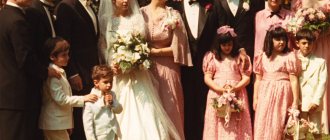Betrothal ceremony (erusin)
For a long time, the fate of the young was decided by parents with the help of matchmakers; among the Jews they are called yents. The agreement on the upcoming marriage was reached by the parents, and the newlyweds met for the first time only during the wedding ceremony - Chuppah. Nowadays, parents allow the bride and groom to meet before the wedding, but premarital relations are still not approved.
After the parents discuss all the issues related to the upcoming marriage, the groom comes to his betrothed’s father and asks permission to marry. This is the tradition. The groom pays a bride price in order to confirm his intentions.
But among Jews, ritual ceremonies associated with a wedding begin long before marriage. Sometimes quite a lot of time passes between the engagement and the wedding itself, so for some nationalities the bride and groom began their marital relationship before marriage.
Ancient traditions
Since ancient times, the parents of the newlyweds have agreed on the wedding. The bride and groom met after reaching agreements, often seeing each other for the first time. Since quite a lot of time passed before the wedding ceremony, in some regions the arranged young people began to live together without waiting for officially formalized marriage bonds.
A wedding in Israel and the institution of marriage in general were perceived not only as the unity of a man and a woman for procreation, but also as the embodiment of the Divine command. After all, according to the Torah, someone who has not created a family is not a full-fledged person. He is not complete - somewhere in the world, just as separately, his half lives.
Jewish wedding traditions
Tenaim is considered the first wedding ceremony after betrothal among Jews. During the ceremony, a plate is broken as a symbol of the grief of the Jewish people over the destroyed temples of Jerusalem. Even on days of joy and celebration, they remember tragic events.
The wedding day is also not chosen by chance. It is not celebrated on the Sabbath, which lasts from Friday sunset until Saturday evening. Wedding rituals are not performed during Jewish holidays, such as the Jewish New Year. These days, not a single devout Jew works. Some Jews began the wedding ceremony immediately after the end of Shabbat, on Saturday evening.
Different Jewish nations had their own rules for designating the day of the Hupa ritual. The Mishnah suggested holding the wedding on Wednesday, so that the husband, having discovered his wife to be unclean, could immediately declare this in court on Thursday. In Poland, Bohemia and Austria, Jews combined the ceremony of marriage with the Shabbat meal to save money. Nowadays, many people hold weddings on weekdays during the week, unlike Russian weddings. But Sunday remains the most popular wedding day.
It is customary for the groom to buy a ring for the bride shortly before the wedding. It should be modest, without unnecessary decorations, engravings and stones, so that the surface of the ring is smooth and not demarcated by anything.
A lot of guests
There were a lot of guests at the wedding where I attended. As it turned out, all of them are close friends of the bride and groom, as well as relatives from both sides of the couple. All guests invited to a Jewish wedding must be dressed according to certain rules: men are allowed to attend the celebration only in strict black suits and hats, women have it easier: their clothes can be anything, but they cannot come in trousers and especially shorts (cleavage and mini ones are also prohibited).
I was surprised that at a Jewish wedding there are no groomsmen, witnesses, matchmakers, matchmakers and other actors, without whom not a single wedding is complete: there are only the bride and groom and invited guests - no more distribution of roles.
The only thing I paid attention to was the accompanying bride and groom, their retinue, so to speak. The thing is that in the last days before the wedding, the newlyweds are treated like royalty, so they must be accompanied by an “entourage” everywhere. Each of them should also be brought into the ceremonial hall by the same “retinue”, holding lit candles in their hands.
Cindy Crawford is unrecognizable as a child. Cute photos from the 1960s
Take your own socks: rules for choosing shoes for training
Nastya Kamenskikh told how to force yourself to play sports
It was also surprising that all the guests in the hall were divided into two categories, based on gender. As they say, boys to the left, girls to the right. In the “female” half of the hall, separated from the “male” by a small screen, the bride sits and waits for her future husband. As soon as he arrives at the hall, he comes for his beloved, covers her face with a veil, and then takes her hands, and together they go to the rabbi, who conducts the wedding ceremony.
Visiting the Mikvah before a Jewish wedding
Meanwhile, the future wife is also preparing for the wedding ceremony. She visits a special pool - the Mikvah, where a cleansing ritual is performed for the start of a new family life. Nowadays, there are complexes that are not inferior in equipment to modern European-style sports clubs.
It is very important to undergo cleansing of both soul and body during the ritual. The girl undresses, takes off her jewelry, even wipes off her nail polish and gradually lowers herself into the waters of the sacred pool, reading a special prayer. There may be several immersions in water to achieve the full cleansing effect. Sometimes men also go to the Mikvah, only in the absence of women.
The bride is not alone in the Mikveh; other women of the family are present with her, who help her in carrying out the ritual. During cleansing, a conversation is held with the bride about family values and the female role in married life. An inexperienced bride is mentored by a respected and religious woman who imparts rich life experience to her.
Royal week
Customs require that the newlyweds not see each other for a week before the wedding. And during this time you need to do a lot of things. The bride must undergo a ritual of ablution - a mikvah. This is a kind of cleansing in a sacred pool, before an important event.
for the groom to do. On the last “free” Saturday, he must be in the synagogue and show everyone how well he knows and interprets the Torah. A traditional cheerful song is played for him , and women shower him with sweets.
At this time, the bride has Leisurely conversations are held, the girls wish their friend happiness and peace in the family.
The week before the Jewish wedding
It used to be that future spouses should not meet a week before the wedding. But now no one follows this tradition. Even in the old days, the young bride and groom fasted before the wedding ceremony, but now only the groom observes the fast, and even then only on the wedding day. Although there is also a rational grain in this custom - newlyweds enter family life completely cleansed and renewed. Religion plays a huge role in Israeli wedding traditions, but in the modern world, few Jews adhere to them as strictly as they once did.
Preparation period
In preparing the Jewish wedding ceremony, the parents of the future newlyweds play an important role. It is they who first discuss with each other issues of weddings and material contributions to the life of the newly created family. Only after an agreement is reached between them, the groom has the right to come to the father of his bride and ask for her hand. As a sign of the seriousness of his intentions, he is obliged to pay a ransom for his beloved. And thus a written or oral agreement is concluded to hold a Jewish wedding.
It cannot be done without the interaction of mothers. According to wedding tradition, to seal this agreement, they break the plate as a symbol of the impossibility of returning everything back. After this, it is time to set the wedding day. It also has its own characteristics and prohibitions. So, you cannot get married during:
- Shabbat is a holiday among the Jewish people, on which it is customary to abstain from work and other activities;
- Jewish national holidays;
- fasting and days of remembrance of the dead.
According to the traditions and customs of a Jewish wedding, the preparatory period ends with two special ceremonies for the bride and groom. A week before the main event in his life, the groom announces to the community about the upcoming wedding during a service in the synagogue - the Ufruf ceremony. The men present applaud his decision, shower him with candy, and a festive dinner takes place for the family.
The bride undergoes a cleansing ceremony. She visits the special Mikvah pool in the company of other women of the family, reciting prayers from the Torah in it. It is believed that after this she comes out cleansed and renewed, ready for a new life.
Jewish wedding ceremony (nisuin)
The main wedding ceremony of Chuppah does not necessarily take place in the Synagogue. It requires a rabbi and the chuppah itself, so this ritual can be performed in a variety of places. The rabbi himself can both conduct the ceremony and observe its performance by one of the respected relatives.
The chuppah is the canopy under which a couple of lovers sits during the wedding ceremony. It is built from four pillars and covered with cloth to create a semblance of a house, which the chuppah symbolizes. According to tradition, the groom is the first to enter under the chuppah, representing the owner of the house. Then, accompanied by the father or both parents, the bride enters under the canopy. This means that her husband provides her with shelter, clothing and assumes all maintenance obligations. Moreover, the bride appears in the “house” last, walking around her future spouse. There is no consensus on how many circles the bride should do. Some believe that once is enough, but Orthodox Jews insist on seven circles. It is customary among Ashkenazi Jews for the groom to cover his bride's face with a veil before she enters under the chuppah. This gesture symbolizes the husband's intention to protect his wife, and dates back to when Rebecca married Abraham.
This is followed by a ring or engagement ceremony. A Jewish wedding traditionally begins with the reading of blessings before the engagement ceremony. These blessings are first read over the wine, then the betrothal blessing begins. After the blessings, the newlyweds drink ritual wine. According to old customs, the groom presents the young man with a ring (it should be flat and simple) and pronounces solemn words. The groom places the ring on the bride's right hand on her ring finger. If traditions are strictly followed, the bride does not put a ring on her husband’s hand under the chuppah. Some people neglect traditions, while others do not break them, and the ring is placed on the groom outside the chuppah.
Blessings have a magical number of seven. They are read either by a rabbi or by respected men. It is a great honor to read a blessing for invited guests, so each person gets only one. The groom is given a glass of wine, from which he drinks after the blessings, after which the wine is given to the bride.
A very beautiful final tradition of a wedding ceremony is the breaking of a glass. Before breaking it, the glass is wrapped in cloth to prevent small fragments from scattering. The groom must crush the glass with his right foot. At this time, all the guests shout “Mazel tov!”, wishing the young couple a happy fate.
Chuppah
The wedding ceremony takes place under the chuppah - a special canopy that symbolizes the house that the new couple will build together. It is open on all sides - like the tent of the great righteous Abraham and Sarah, who, expressing their unique hospitality, kept all its entrances open in order to be able to welcome and receive travelers coming from all parts of the world.
Among the Ashkenazis, it is customary for the chuppah ceremony to take place on the street in the open air - as a sign of the blessing given by the Almighty to the forefather Abraham that his descendants will be as numerous as the stars of heaven.2
Sephardim usually hold chuppah indoors.
According to some traditions, while standing under the chuppah, the bride and groom should not wear any jewelry. Their new mutual obligations are based on who they are as people, not on what material possessions they own.
The bride follows the groom to the ceremony site. Both are usually accompanied by their parents.
During the Ashkenazi chuppah, the kala circles the hatan seven times. Just as the world was built in seven days, the bride seems to be building the walls of the new world that their couple will form.
In addition, the number seven symbolizes integrity and completeness, which people cannot achieve individually, but only by forming a family.
Then the kala stands to the right of the hatan.
The Sephardic tradition is that at the beginning of the festive evening, the groom recites the Sheheyanu blessing on his new tallit, implying that this blessing also applies to the entire marriage. After this, four of his friends stretch this tallit over the heads of the bride and groom, forming a chuppah from it.
Subtleties of a Jewish wedding
Jews do not have special wedding dresses. Usually the groom wears a black classic suit and tie. The bride wears a white dress, and the dress should be modest and closed. All men at the wedding, led by the rabbi, wear white skullcaps on their heads.
At the beginning of the wedding celebration, the Ketubah is signed - a marriage contract, which spells out all the responsibilities of the spouse and the amount that the husband pays to his wife in the event of a divorce. Also in the Ketubah, the husband confirms his consent to give his wife a divorce document - a get, which will allow her to re-enter into a legal marriage.
There is no special music for a wedding ceremony. Some play Wagner's Wedding March during the wedding, but this composer is known to history for his Nazi views. Therefore, the majority prefer light Jewish music, which carries the traditions and character of the Jewish people.
Many ethnic historians claim that the custom of throwing a wedding bouquet to bridesmaids originates from Jewish weddings.
Marriage contract at a Jewish celebration
Immediately before the wedding ceremony, an agreement is signed - Ketubah. The rabbi enters on a beautiful form, as in the photo , all the obligations that the groom promises to fulfill in the family.
First of all, it is food, clothing and intimacy. Compensation is provided in case the spouse wants to break off the relationship, as a rule, this is a considerable amount. It is called upon, if something happens, to reason with the man and warn against hasty action. All rights of the wife are also spelled out.
If the future spouses agree with everything, then they, together with two witnesses, always men, sign the agreement and give it to the rabbi. This paper will be read out in front of all the guests at the moment when the groom gives the ring to the bride.
Editor's choice: Wedding styles and flowers in decoration
Wedding feast
Believing Jews, following traditions, organize a holiday separately for men and women, eating only kosher food during the feast. There are also those who change the menu and serve vegetarian or fish dishes to guests, and kosher dishes are prepared for some guests. To avoid unpleasant moments during the feast, it is better to fully comply with tradition and treat guests to traditional food.
Depending on your ethnic group: Ashkenzi or Sephardi, different dishes may be present on the wedding table. Ashkenazis fry chicken and serve it with potatoes and various vegetables. Sephardim cook lamb or chopped chicken along with couscous (rice), generously sprinkled with spices and seasonings.
The further wedding ceremony is similar to the weddings of other nations. The holiday should be fun and on a grand scale. All wedding guests must dance the national Jewish dance - Hora. Men congratulate the newlyweds, give parting speeches, and present gifts. At the wedding there is music, depending on religion it differs in different families. Orthodox Jews accompany the wedding celebration only with national Jewish music, while others listen to mixed playlists consisting of modern and traditional musical compositions.
Badkhen is still present at many weddings - jester, buffoon, toastmaster in literal translation. He is the one who entertains all the guests during wedding ceremonies.
For seven days, the newlyweds continue festive feasts for the health of the young. Each time, new guests are invited who have not yet congratulated the newlyweds. After the end of the feasts, the couple in love can enjoy each other’s company during their honeymoon, because during the wedding they had no time to be alone.
Jewish wedding celebrations
The wedding could be scheduled on different days, according to established rules. According to one of them, the wedding took place on Wednesday, so that on Thursday, if the girl lacked virginity, the husband could publicly divorce in the synagogue.
Celebrated on weekdays during the week, and on Saturday after a late dinner. Sunday remains the most popular.
Wedding outfits
Jews do not wear any special wedding attire. They dressed in elegant clothes of the region where they lived. Modern wedding dresses and suits have a very classic look. The only condition is that the bride’s dress should be as modest and closed as possible.
Morning of the wedding day
On the wedding day, the legal issues of the upcoming marriage were first resolved. The groom, together with the bride's representatives, guests and rabbis, signed the engagement agreement and the marriage contract. Meanwhile, the bride received congratulations and gifts in the women's quarters. And the mothers of the newlyweds broke something glass in memory of the destroyed Temple of Jerusalem.
Then the groom, in the presence of respected witnesses, threw a long thick veil over the bride’s head, which completely hid her - as a sign that the man was now fully responsible for his wife. The presence of strangers was necessary to make sure that the girl was not replaced.
Wedding - chuppah
The name of the most important rite comes from the name of the canopy. His presence over the heads of the newlyweds was mandatory. This fabric, decorated with fringe and embroidery, on four carved pillars symbolized the canopy of the groom's house, under which he introduced his wife. The open sides represented hospitality, because this is how the tent of Abraham was opened to all those who suffered. There should not have been any furniture in the chuppah, because a Jewish home is not things, it is the people living in it. Traditionally, there was supposed to be an open sky above the canopy, so the ceremonies were performed outdoors.
The man was the first to enter his “house”, after which the woman entered and walked around the groom in a circle three or seven times - a sacred number. The position of a wife in a Jewish family was special, unlike either Muslim or European customs. Despite the external signs, which are quite similar to those of the East, Jewish women were the cement that held together family ties. They were educated, smart and much less limited in their capabilities.
The rabbi read prayers, blessed the wine in a crystal goblet, and allowed the groom to put on his wedding ring. According to Jewish customs, the ring was intended only for the wife. It was simple, without stones or frills, flat. After this, blessing prayers were read, and the young people drank wine from a goblet. The groom broke the empty vessel - threw it on stones or stepped on it with his right foot. And the guests shouted: “Happy fate!” Modern newlyweds often replace the glass with an incandescent light bulb - it is easier to hit and much louder.
Festive feast
The Jewish people have always had a very specific attitude towards food. Therefore, exclusively kosher dishes were prepared for the festive banquet. But the Torah did not forbid having fun, singing songs and dancing, so we walked from the heart. All guests were expected to entertain the newlyweds to the best of their ability. The holiday lasted until sunrise.
National dances and entertainment
From time immemorial, dancing at a Jewish holiday has been the main way to have fun. Many different traditional dances have been invented specifically for weddings. Many of them still dance.
- The dance for the bride included the use of various funny little things - jump ropes, confetti, flags and fancy dress costumes, everything that dear guests could think of.
- If the last daughter was married, then her mother was crowned with a flower wreath and went out to the center of the hall, and all her daughters danced around her.
- If the last child of either sex was married, a separate dance was held for the parents.
- The Hora and Mitzvah were danced when respected people danced with or for the bride, holding belts in their hands. After which the bride and groom made a joint exit.
The Jewish wedding took place to live national music with rare inclusions of musical compositions from the region of residence, because these people settled all over the world. Modern weddings also include national compositions and dances, and generally accepted playlists.
Interesting customs of a Jewish wedding
Like all other peoples, Jews have their own original traditions and signs, which they strictly observe during the wedding - after all, the well-being and happiness of the newlyweds depends on this. Particularly interesting in this regard are the weddings of Orthodox Jews, which have remained virtually unchanged since ancient times.
- Since marriage is a sacred act for the bride and groom, they are forbidden to eat or drink anything other than clean water until the sacrament of betrothal.
- All traditional Jewish rituals have their origins in the Torah. They are very religious and strictly observe the commandments and laws of God.
- After the engagement, the newlyweds must retire to a separate room in the presence of several witnesses and share a meal together. After this, the official part of the wedding ends.
- At the festive feast, the newlyweds were necessarily lifted into the air along with the throne-chairs, and carried around in a circle with songs and congratulations.
- The young people at the wedding are the embodiment of Divine providence, they are full of holiness and their status is higher than everyone else present, regardless of merit and age. The attitude towards them these days is appropriate. For many young people, the period of marriage is the most important in life.
- As in the Muslim tradition, Jews do not celebrate together between men and women. During special events and banquets, it is customary to separate according to gender, and separate tables are placed.
- A married woman should not show her hair to anyone except her husband. Therefore, in public they appear either in completely closed headdresses, scarves, or shawls. Or - in wigs.
- The end of the holiday is marked by a prayer of thanks.
- The custom of throwing a bouquet into a crowd of girlfriends began its victorious march precisely from the Jewish tradition.
- At many weddings there is still an official jester-toastmaster, badchen. He entertains guests, organizes competitions and various jokes.
- There is a wonderful old custom that is still observed: when a son is born, parents plant a cedar tree, and if a daughter is born, a pine tree.
Even zealous keepers of traditions give in under the pressure of modern technology. Increasingly, celebrations are being filmed on video or with cameras, although previously it was strictly forbidden to record secret rituals and people in general.
When the newlyweds returned, the dancing began
As soon as Sophia and David returned to the guests, the dancing began, and the center of attention of the dancers was the newly-made husband and wife. It was then that I saw what the famous Jewish wedding dance on chairs was. Young boys and grown men instantly sat David on a chair and lifted him up to loud cheers, the same fate awaited Sophia, but girls and women carried her on the chair - an amazing sight, I tell you.
64% of Russians dream that their children will work in the field of science: survey result
Not at all. Statistics show what men want on February 23
“Typical French - they don’t care”: the world champion gave up in the middle of the race
What surprised me most was that in a Jewish wedding there is no such thing as the first dance of the newlyweds, since during the festivities women are forbidden to move to the men’s part of the hall and vice versa. However, no one forbids spying on each other.











